Big Island whale watching big island: A Complete Guide
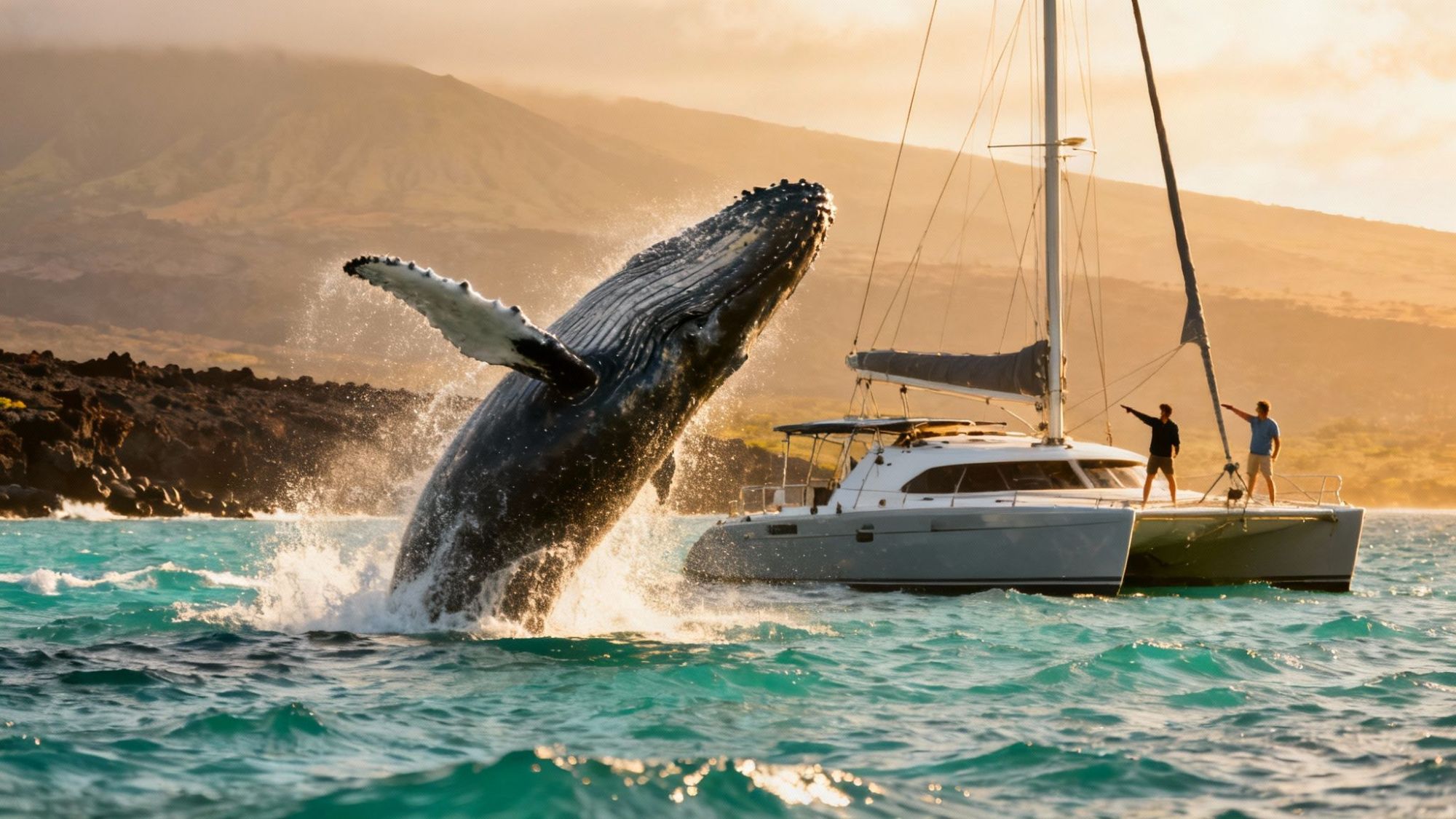
Picture this: a 40-ton humpback whale explodes from the turquoise water, its massive body silhouetted against the Big Island’s dramatic volcanic coastline before crashing back down in a spectacular splash. This isn't just a scene from a nature documentary; it’s a real, raw, and regular sight during Hawaii's magical whale season.
When it comes to whale watching in Hawaii, the Big Island is in a class of its own, especially from December through March along the sun-drenched Kohala Coast.
Your Ultimate Big Island Whale Watching Adventure
This guide is your firsthand pass to planning that once-in-a-lifetime encounter. We want to help you turn a simple boat trip into a profound connection with these gentle giants of the deep. We’ll cover everything from the best times and places to spot them to choosing a tour operator that puts the whales' well-being first.
Speaking of which, you'll want to be in good hands. An operator like Kona Snorkel Trips, the top rated & most reviewed snorkel company in Hawaii, has a reputation that speaks for itself. It’s about more than just seeing whales; it's about the entire experience.
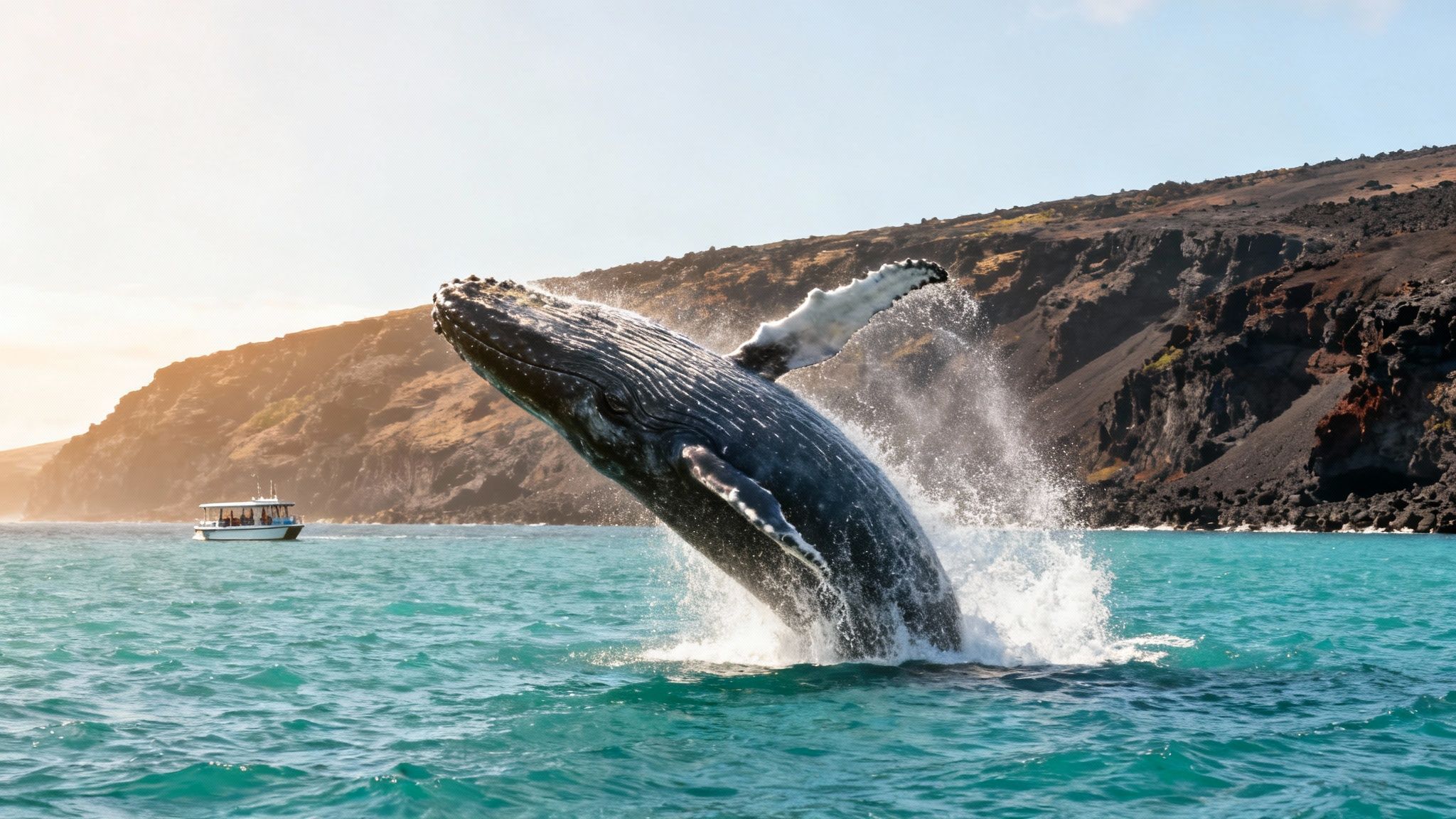
Why Is the Big Island a Whale Watching Hotspot?
There's a reason the Big Island has become such a major hub for humpback activity. The annual Sanctuary Ocean Count, a fantastic community-led initiative, consistently backs up what local boat captains have known for decades: these waters are a preferred destination for migrating humpbacks.
During the January 2025 count alone, dedicated volunteers tallied nearly 500 humpback whales from over 30 different shoreline sites around the island. Think about that for a second. That impressive number was part of a statewide total of 2,121 whales spotted on a single day, highlighting just how crucial our island is to the entire Hawaiian whale migration.
You can dive deeper into the Big Island’s recent whale counts and what they mean for the population.
What This Guide Covers
We’re going to walk you through everything you need to know for an unforgettable whale watching Big Island experience. Together, we will explore:
- The incredible journey humpback whales make to Hawaii each year.
- The absolute peak season and the best spots for sightings.
- How to pick a tour that's both thrilling and ethical.
- What to actually expect and how to prep for your day out on the water.
By the time you're done reading, you'll be fully equipped to plan an adventure that connects you with one of nature’s most awe-inspiring events. Let's get you ready for the water.
The Epic Journey of Hawaii's Humpback Whales
Every winter, something magical happens in the waters off the Big Island. It’s the grand finale of an absolutely epic pilgrimage: a grueling 3,000-mile journey humpback whales make all the way from the frigid, food-filled seas of Alaska. This isn't just a casual swim south for the winter; for many of these whales, it's the most important trip of their lives.
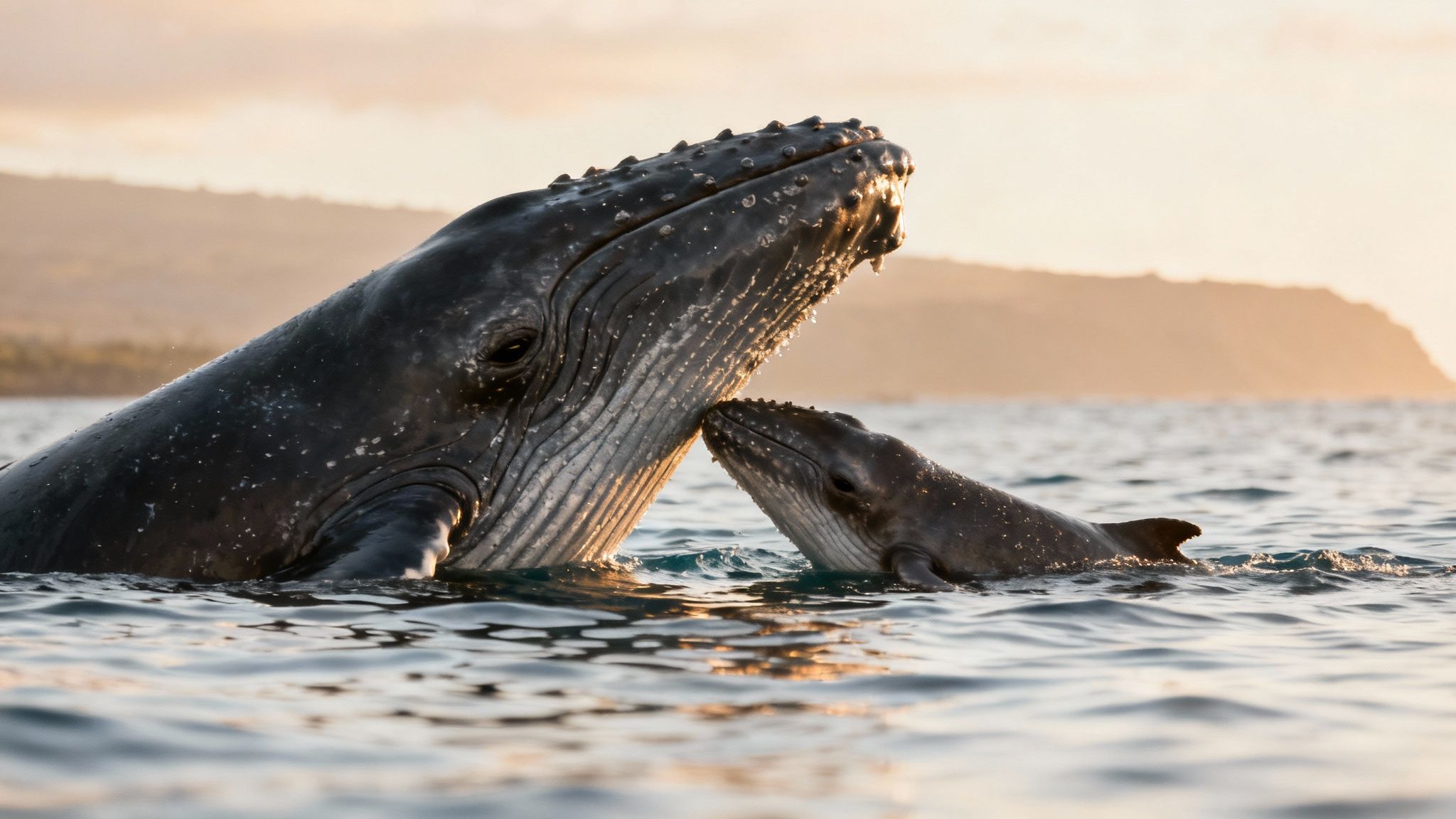
This massive migration, one of the longest for any mammal on Earth, takes them about six to eight weeks to complete. And get this—they don’t eat the entire time. They live completely off the thick blubber reserves they packed on during their summer feeding frenzy in Alaska, which tells you just how critical this destination is.
Why Hawaii's Warm Waters?
So, what’s so special about Hawaii? After a trek like that, why here? The answer is all about new life. The Hawaiian Islands, especially the protected channels around the Big Island, offer a safe, warm haven far from their main predators, like killer whales.
This place is the perfect sanctuary for the most important parts of the humpback life cycle:
- Mating and Courtship: Male humpbacks put on an incredible show to compete for mates. You'll see them launching their bodies out of the water in massive breaches, slapping their tails, and hearing their complex, haunting songs underwater.
- Giving Birth: Pregnant females come here specifically to give birth. The warm, calm coastal waters are a huge help for newborn calves, allowing them to save precious energy instead of fighting off the cold.
- Nursing and Raising Calves: A newborn calf can weigh up to 2,000 pounds at birth! They need to bulk up fast for the long trip back north, so they'll drink around 100 gallons of their mother’s super-rich milk every single day.
Think of the waters off the Big Island as a crucial nursery. With no predators lurking and the calm, warm conditions, newborn calves get the best possible head start in life. They can focus entirely on growing strong enough for their very first migration.
When you're out on a whale watching Big Island tour and see a powerful breach or a quiet, gentle moment between a mother and her calf, you're getting a front-row seat to a fundamental chapter in their lives. Knowing the "why" behind their journey adds a whole new layer of awe to what you're seeing. It’s a genuine privilege to watch this ancient, instinct-driven cycle play out right in front of you.
When and Where to See Whales on The Big Island
If you want to have a truly mind-blowing whale watching experience on the Big Island, timing is everything. It’s not just about showing up during "whale season"; it's about knowing the rhythm of the migration to put yourself in the right place at exactly the right time for the best show.
While you might spot the first humpbacks arriving from Alaska as early as November, and the last ones heading back in April, the real magic happens in a much tighter window.
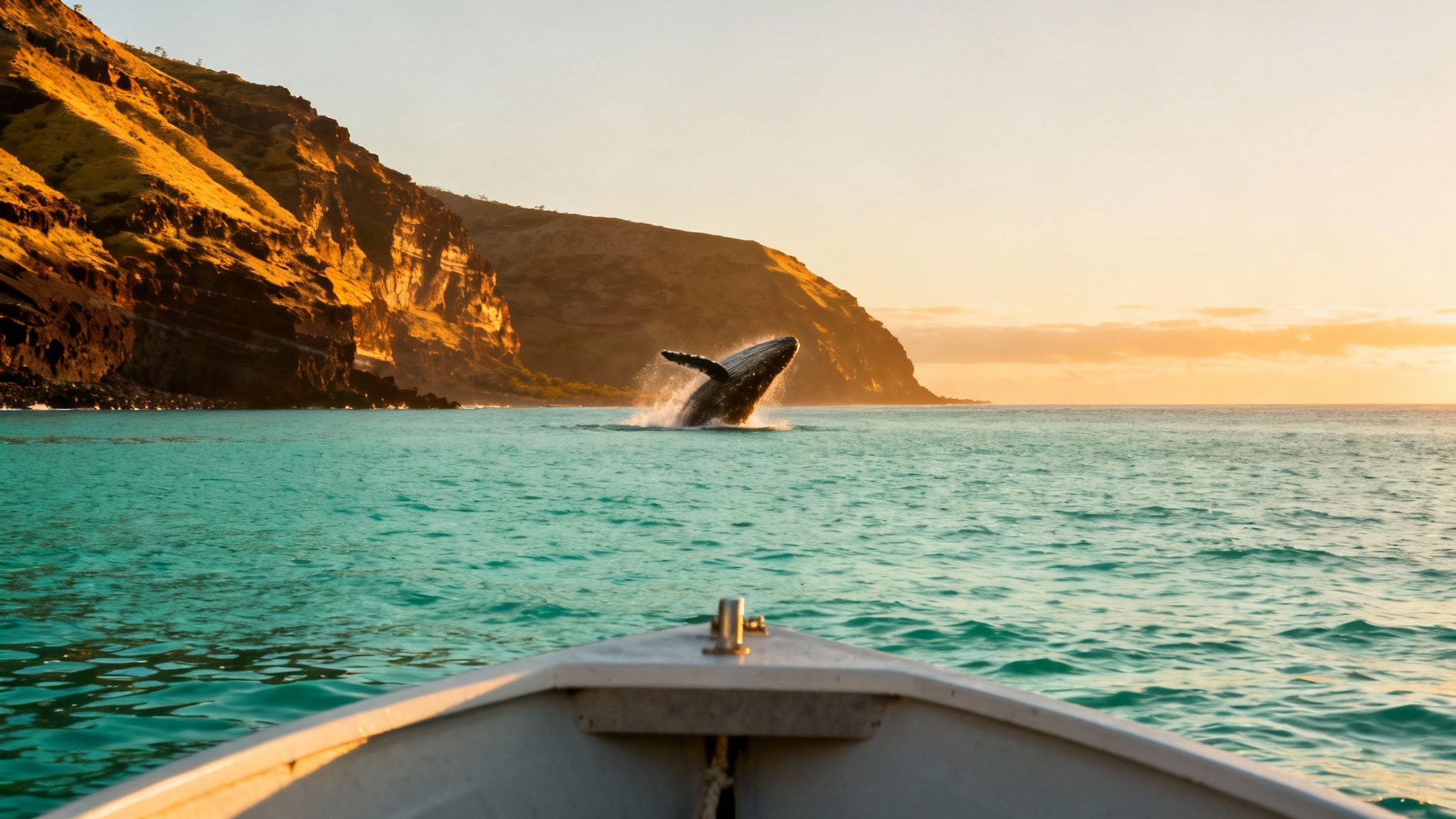
The absolute sweet spot for whale watching on the Big Island is January and February. This is when the population hits its peak. The waters are just buzzing with activity—from massive males competing for mates to new mothers teaching their calves how to be a whale.
If you can plan your trip during these two months, your chances of seeing multiple, spectacular encounters go way, way up.
Big Island Whale Watching Planner
To help you pinpoint the best opportunities, here’s a quick guide to our top whale-watching zones. This table breaks down where and when you'll have the best luck spotting humpbacks during their stay in Hawaiian waters.
| Location | Peak Months | Best Time of Day | Viewing Type |
|---|---|---|---|
| Kohala Coast | January-February | Morning (7-10 AM) | Boat Tours, Shoreline |
| Kona Coast | January-February | Morning (8-11 AM) | Boat Tours, Kayak |
| Hāmākua Coast | December-March | Mid-day | Shoreline (Scenic Drives) |
| Puʻukoholā Heiau | January-February | Morning | Shoreline (National Park) |
While you can spot whales all around the island, the data consistently points to the Kohala Coast as the premier destination. It's the perfect combination of conditions that makes it a true humpback hotspot.
The Kohala Coast: Ground Zero For Whales
You can catch glimpses of whales from many spots around the island, but if you're looking for the undisputed champion, it's the Kohala Coast. This stretch along the northwestern side of the island is a humpback's paradise. The waters here are calm, sheltered, and relatively shallow, creating the ideal nursery for mothers to rest and raise their newborns.
And it's not just a hunch—the numbers back it up. Sightings along the Kohala Coast can be two to three times higher than anywhere else, especially during that January and February peak.
Even the time of day you go matters. Early morning trips, especially around 8 a.m., tend to have about 50% more sightings than afternoon tours. This is likely due to the calmer ocean conditions and the whales' natural activity patterns.
The Best Time of Day For Your Tour
Beyond picking the right month, scheduling your tour for the morning can make a huge difference in your experience. There are a few solid reasons why the early bird gets the whale:
- Glassy Seas: The ocean is often at its calmest first thing in the morning before the trade winds kick in. This means a smoother ride for you and an easier time spotting those tell-tale spouts on the horizon.
- More Action: Humpbacks often seem to be more energetic and playful in the morning hours. This is your best shot to witness jaw-dropping breaches, tail slaps, and other exciting surface behaviors.
- Picture-Perfect Light: That soft morning sun is a photographer's best friend. It helps you capture those incredible moments without the harsh glare of the midday sun washing out your photos.
For a deeper dive into planning your adventure around the whales' schedule, check out our complete guide to the Big Island whale season. Aligning your trip with these peak times and locations is the best way to set yourself up for a whale watching adventure you'll never forget.
Choosing Your Ideal Whale Watching Tour
Not all whale watching tours are cut from the same cloth. Picking the right one can be the difference between a pretty good day and a truly unforgettable one. It's a bit like choosing a vehicle for a road trip—what a solo adventurer needs is a world away from what a family of five requires. The same logic holds true for selecting your perfect whale watching Big Island tour.
Your first big decision point is the boat itself. Each type of vessel offers a completely different vibe out on the water.
Vessel Types: The Big Island Experience
The boat you're on directly shapes how you'll see and experience the whales, so it's worth thinking about what kind of adventure you're really after.
- Large Catamarans: These are your floating living rooms—stable, spacious, and comfortable. They're a fantastic choice for families with small kids, anyone who gets a little queasy on the water, or if you just want to kick back and relax. You'll often find amenities like restrooms and snack bars, making for a laid-back, easygoing trip.
- Smaller Powerboats: If you're looking for a more personal experience, this is it. With fewer passengers, you get a much more intimate setting. These boats are quicker and more nimble, meaning they can often react to a distant spout and get into a great viewing position (while still respecting the whales' space, of course).
- Zodiacs (Rigid-Hulled Inflatable Boats): This is the option for the thrill-seekers. A zodiac tour is about as close to the water as you can get without jumping in. These fast, low-profile boats give you a wild, exciting ride where you'll feel every bit of the ocean's energy. It's less of a tour and more of a rugged adventure.
Hallmarks of a Top-Tier Operator
Beyond the vessel, it's the crew and the company's philosophy that truly make the experience special. A great operator doesn't just point out whales; they help you feel connected to the entire marine world.
Look for tours that put a heavy emphasis on education and conservation. One of the clearest signs of a quality operation is having an experienced marine naturalist on board. These folks are your window into the ocean's secrets. They're the ones who can translate whale behaviors, share incredible facts about the humpback life cycle, and answer all your questions with genuine passion.
A reputable tour operator's number one priority is the well-being of the whales. They will always strictly follow the federal laws requiring boats to stay at least 100 yards away from humpbacks. This respectful buffer ensures the whales aren't stressed and can go about their lives naturally.
Ethical practices are a must. A company's commitment to conservation should be obvious in everything they do. By choosing a tour that puts the animals first, you're doing your part to support a sustainable tourism model that helps protect these incredible giants for years to come.
For a deeper dive into specific options, our guide to the best whale watching tours in Kona Hawaii can help you weigh your choices.
What to Expect on Your Whale Watching Tour
So, you've booked your tour and you're ready to get out on the water. Let's paint a picture of what the day will actually be like, so you can just relax and soak it all in. A little prep goes a long way, and knowing what to expect means you won't miss a thing.
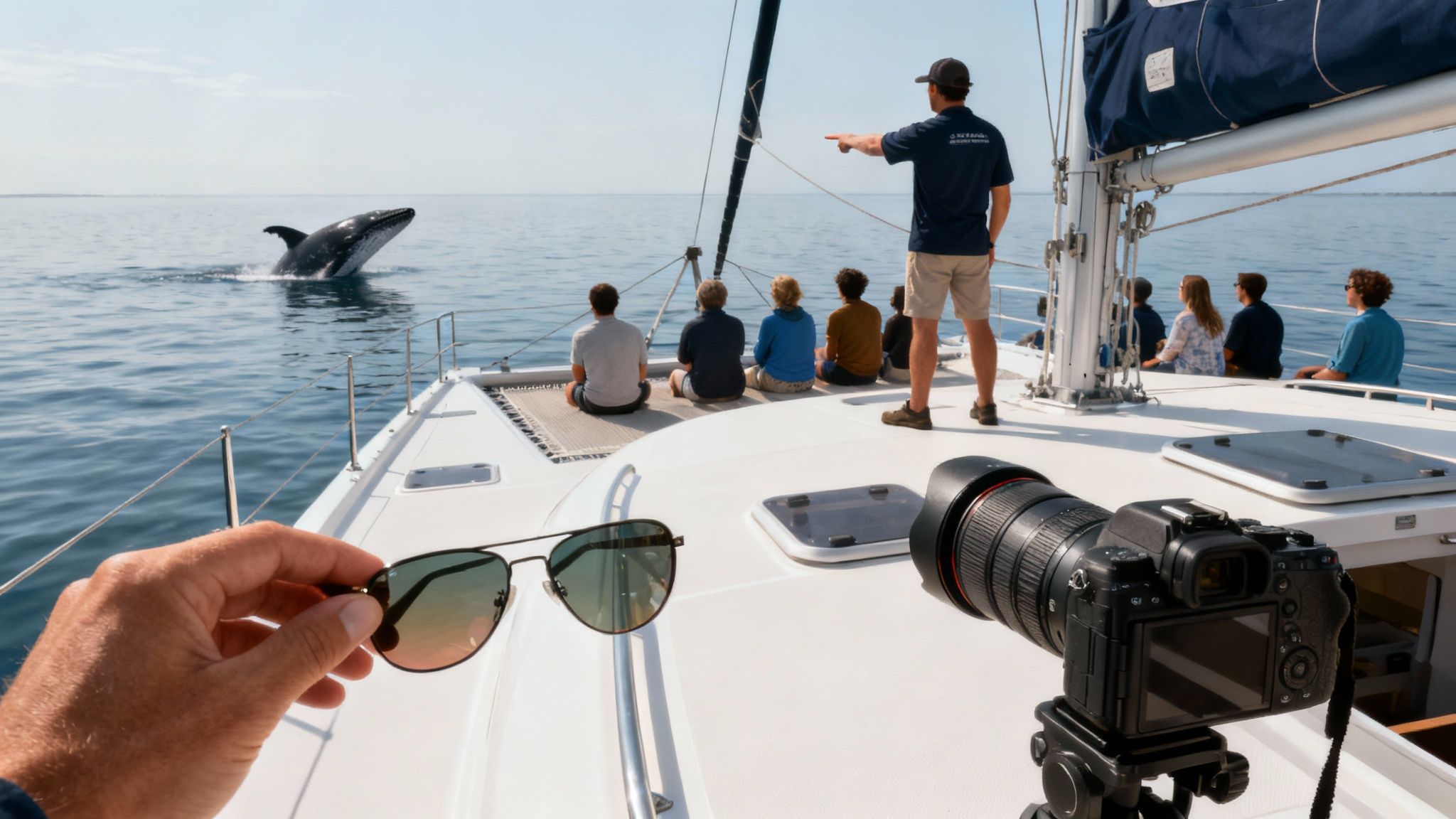
Once you're cruising, your guide will get everyone scanning the horizon for the first signs of whale activity. You’ll learn to listen for the explosive "whoosh" of their breath as they surface. Keep an eye out for their spout—that misty spray can shoot up to 15 feet high and is often the first thing you'll spot from a distance.
Translating Whale Behaviors
Part of the magic of whale watching isn't just seeing them, it's understanding what you're seeing. Humpbacks are incredibly expressive, and all those splashes and jumps are their way of communicating.
You'll quickly learn to spot a few key behaviors:
- Breach: This is the one everyone hopes for—when a whale launches its massive body almost completely out of the water. It’s a spectacular sight, thought to be a way to communicate or maybe just shake off some pesky parasites.
- Tail Slap: You'll hear this one before you see it. A powerful smack of the fluke (tail) on the water creates a sound that travels for miles underwater. It could be a warning to other whales or just a way of saying "I'm here!"
- Spy-Hop: My personal favorite. A whale will poke its head straight up out of the water, almost like a periscope, just to take a look around. It's pure curiosity, and sometimes, you get to make eye contact with these gentle giants. It's a moment you won't forget.
Your Essential Packing Checklist
Trust me, coming prepared makes the difference between a good trip and an unforgettable one. You don't need a ton of gear, but the right items will seriously upgrade your day.
Don't let something simple like a sunburn or seasickness distract you from the show. A little prep ensures you're comfortable, protected, and ready to capture every amazing moment without a single worry.
Here’s your no-nonsense, practical checklist:
- Sun Protection: The Hawaiian sun is no joke, especially when it’s reflecting off the water. Pack reef-safe sunscreen, a good hat with a wide brim, and maybe a long-sleeved sun shirt.
- Polarized Sunglasses: These are a non-negotiable game-changer. They slash through the glare on the water’s surface, making it so much easier to spot whales and other marine life just below.
- Camera with a Zoom Lens: Whales can pop up anywhere, anytime, and often at a distance. If you want great photos, a camera with a decent zoom lens is your best friend. You'll get incredible shots without ever disturbing the animals.
- Motion Sickness Remedy: If you even think you might get seasick, take your preferred remedy before you get on the boat. For some, ginger chews or acupressure wristbands work wonders as a natural alternative.
Discovering Hawaii's Other Marine Life
While the humpback whales are absolutely the main event during the winter, they’re hardly alone out there. Think of a whale watching Big Island tour less like a one-act play and more like a full-blown marine safari. The ocean is teeming with an incredible cast of characters that call these waters home all year long.
Keeping your eyes peeled for these other residents makes the whole experience richer. It’s one thing to see a breaching whale, but it’s another to truly appreciate the entire, bustling ecosystem it belongs to.
One of the most common and purely joyful sightings is a pod of spinner dolphins. True to their name, these guys are the acrobats of the sea, famous for launching themselves out of the water in breathtaking spins. Seeing a whole pod race alongside the boat is an explosion of energy that’s impossible not to smile at.
Beyond the Breaching Giants
Past the dolphins, the deep, clear waters off the Kona coast are a hotspot for other fascinating whale and dolphin species. Every encounter is different and gives you a peek into the complex social lives of these intelligent creatures.
If you're lucky, you might spot:
- Short-finned Pilot Whales: These are incredibly social, dark-colored whales known for their tight-knit family pods. Catching a group of them resting calmly at the surface is a truly serene and peaceful moment.
- Melon-headed Whales: Often spotted in massive groups that can number in the hundreds, these sleek, fast swimmers are a sight to behold as they slice through the water.
Every animal plays a role in the health of Hawaii's marine world. From the smallest reef fish to the largest whale, it's all part of a delicate, interconnected web of life. Observing this biodiversity firsthand is a powerful reminder of what we're working to protect.
A Reminder of Conservation Challenges
The comeback story of the humpback whale is incredibly inspiring, but it's not the only story playing out in these waters. The Big Island is also home to the endangered insular false killer whale, a unique population found only in Hawaii.
Their situation is critical. With only about 140 individuals left and their numbers dropping by 5% each year, they are a stark reminder of the ongoing challenges in marine conservation. You can learn more about the delicate status of Hawaii's whales and dolphins from the Department of Land and Natural Resources to get the full picture.
Of course, the vibrant life doesn't stop with the mammals. You'll likely see sea turtles gliding gracefully by or catch flashes of the colorful fish that make the reefs below so famous. If you want to put a name to the faces you see beneath the waves, our Hawaii reef fish guide is a great resource. Recognizing all these other animals transforms any whale watching tour from a great trip into an unforgettable adventure.
Got Questions? We've Got Answers
To wrap things up, let's go through some of the practical questions that pop up before a trip. Knowing the answers to these details will help you plan your whale watching Big Island adventure with total confidence, so you know exactly what to expect.
Is Seeing a Whale Guaranteed on a Tour?
While tour operators can never 100% guarantee a sighting of wild animals, your chances during the peak season from January to February are ridiculously high—often well over 95%. Experienced captains and crews live and breathe these waters; they know the whales' favorite hangouts and migration patterns, which really stacks the odds in your favor.
Many of the best companies offer a "whale guarantee." What this usually means is if your trip strikes out and you don't see a whale, you can come back for another tour for free. It's always a good idea to ask about a company's specific policy when you book.
What Is the Best Camera for Whale Watching?
If you want to capture those jaw-dropping moments, a camera with a good telephoto or zoom lens is your absolute best friend. It lets you get those stunning, detailed shots from a respectful distance without bothering the whales.
A fast shutter speed is also a game-changer. It’s what you need to freeze the action of a powerful breach or a quick tail slap in a crystal-clear image. But don't sweat it if you don't have professional gear—the cameras on modern smartphones are incredible and can capture amazing photos and videos of your experience.
Are Whale Watching Tours Safe for Children?
Absolutely. Licensed whale watching tours are designed to be safe and fun for everyone, from little kids to grandparents. The captains are highly experienced, and every boat is fully equipped with all the necessary safety gear, including life jackets for everyone on board.
For families with small children, you might want to look for a tour on a larger, more stable vessel like a catamaran. They generally provide a smoother and more comfortable ride for little sea legs.
How Close Can the Boats Get to Whales?
This is a big one. To ensure the safety and well-being of the humpbacks, federal law in Hawaii is very strict: all vessels must stay at least 100 yards away. This rule is especially critical for protecting new mothers and their calves from any potential stress.
But here's the magic of it all—humpback whales are incredibly curious creatures. It’s not at all uncommon for them to decide to approach a boat on their own. This can lead to a truly breathtaking close-up encounter that happens entirely on their terms, which is the most respectful and memorable way to see them.
Ready for an unforgettable marine adventure? For the best ocean experiences on the Big Island, check out Kona Snorkel Trips and see why they are Hawaii's top-rated snorkel company. Book your tour today!
